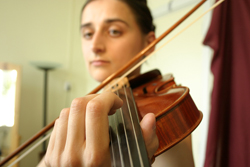Violinists and violists practice for hours to develop a supple and agile left hand technique. Good fingering technique requires the hand to be strong and balanced in its movements. Violinists and violists need to be able to reach all the strings easily, around the neck of the violin, and also from the top to the bottom of each string. The arm must be free to swing under the violin, and the forearm should be free to rotate. Being able to open the hand easily is essential to provide the stretch necessary for playing double stops or wide intervals along one string. When the hand is cramped by tension further up the arm or in the neck it is not possible to move the fingers easily and quickly.

When the player's neck is stiffened, the left arm also stiffens and the range of the movements in the joints is decreased. The left arm cannot swing freely in the shoulder socket, the elbow joint cannot open easily, the wrist stiffens and the fingers cannot stretch. The rotation of the forearm is limited by the immobility in the arm further up with the tension originating in the neck. A well-fitted chin rest can decrease the necessity for shortening and cramping the neck, which can help to free the left hand.
>>Neck
Left shoulder movement is often blocked by an ill-fitting shoulder rest. In the effort to stabilize the instrument for playing, the shoulder may be pulled up and forward, with the chest muscles also contracted. This causes the entire arm to contract, and all joints stiffen. The upper arm is also often pressed against the side (ribs) which can affect blood circulation, leading to cold hands. Positioning the shoulder rest so that it does not press on the tip of the shoulder or the chest muscles makes it possible for the shoulder joint to move more freely. >>Left shoulder
“My shoulder rest was very big, blocking the freedom of the left hand so that my fingering hand felt cramped all the time. Since my shoulder was blocked, my arm was effectively shortened, making difficult all techniques in which I had to open my hand. For instance, I couldn’t stretch my hand to reach the interval of a 10th. The result of this situation was tension in my whole body. I spent many extra hours practicing the same passages over and over, without knowing why it didn’t get any better.” -Iren
The combined tension makes it hard for the player to reach with the fingers under and around the fingerboard. Lack of mobility in the shoulder joint blocks the free swing of the elbow under the instrument necessary for quick access to all strings. Loss of the range of movement in the rotation of the lower left arm makes it even more difficult to position the fingers with ease where they are needed. With the stretch in the hand decreased, double stops and reaches, as well as basic dexterity suffers. Wrist stiffness affects the quality of the vibrato.
Adjusting the equipment and re-training the joints to move freely improves playing conditions in the neck, shoulder, and arm, which allows the left hand to function well.

